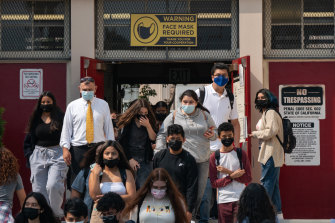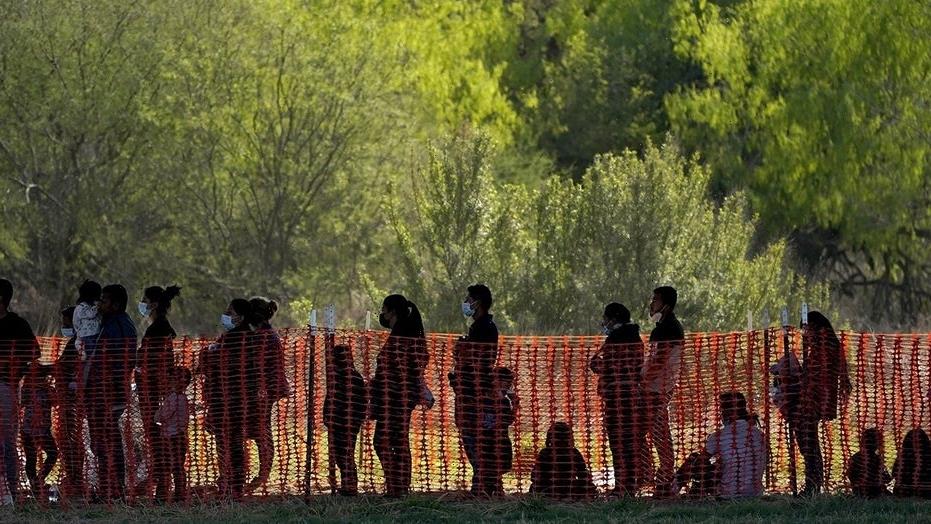For our free coronavirus pandemic coverage, learn more here.
New York: Since Americans began rolling up their sleeves for coronavirus vaccines, health officials have said that those who were immunised were very unlikely to become infected, or to suffer serious illness or death. But preliminary data from seven US states hint that the arrival of the Delta variant in July may have altered the calculus.
Infections in vaccinated people – referred to as breakthrough infections – accounted for at least one in 5 newly diagnosed cases in six of these states and higher percentages of total hospitalisations and deaths than had been previously observed in all of them, according to figures gathered by The New York Times.
The absolute numbers remain very low, however, and there is little doubt that the vaccines remain powerfully protective. This continues to be “a pandemic of the unvaccinated,” as federal health officials have often said.
Students and staff exit Hollywood High School in Los Angeles. California is among states where infections in vaccinated people accounted for 12 to 24 per cent of COVID-related hospitalisations.Credit:Bloomberg
Still, the rise indicates a change in how vaccinated Americans might regard their risks.
“Remember when the early vaccine studies came out, it was like nobody gets hospitalised, nobody dies,” said Dr Robert Wachter, chairman of the department of medicine at the University of California, San Francisco. “That clearly is not true.”
The figures lend support to the view, widely held by officials in the Biden administration, that some Americans may benefit from booster shots in the coming months. Federal officials plan to authorise additional shots as early as mid-September, although it is not clear who will receive them.
“If the chances of a breakthrough infection have gone up considerably, and I think the evidence is clear that they have, and the level of protection against severe illness is no longer as robust as it was, I think the case for boosters goes up pretty quickly,” Wachter said.
The seven states — California, Colorado, Massachusetts, Oregon, Utah, Vermont and Virginia — were examined because they are keeping the most detailed data. It is not certain that the trends in these states hold throughout the country.
With COVID-19 restrictions lifted, fans watch a baseball game between the St. Louis Cardinals and the Colorado Rockies in Denver.Credit:AP
In any event, scientists have always expected that as the population of vaccinated people grows, they will be represented more frequently in tallies of the severely ill and dead.
“We don’t want to dilute the message that the vaccine is tremendously successful and protective, more so than we ever hoped initially,” said Dr Scott Dryden-Peterson, an infectious disease physician and epidemiologist at Brigham & Women’s Hospital in Boston.
“The fact that we’re seeing breakthrough cases and breakthrough hospitalisations and deaths doesn’t diminish that it still saves many people’s lives,” he added.
The Centres for Disease Control declined to comment on the states’ numbers. The agency is expected to discuss breakthrough infections, hospitalisations and vaccine efficacy at a news briefing on Wednesday (Thursday AEST).
Most analyses of breakthrough infections have included figures collected through the end of June. Based on the cumulative figures, the CDC and public health experts had concluded that breakthrough infections were extremely rare, and that vaccinated people were highly unlikely to become severely ill.
The states’ data do affirm that vaccinated people are far less likely to become severely ill or to die from COVID-19. In California, for example, the 1615 hospitalisations of people with breakthrough infections as of August 8 represents just 0.007 per cent of nearly 22 million fully immunised residents, and breakthrough deaths an even smaller percentage.
But in six of the states, breakthrough infections accounted for 18 per cent to 28 per cent of recorded cases in recent weeks. (In Virginia, the outlier, 6.4 per cent of the cases were in vaccinated people.) These numbers are likely to be underestimates because most fully immunised people who become infected may not be taking careful precautions, or may not feel ill enough to seek a test.
“There’s just a lot more virus circulating, and there’s something uniquely infectious about the variant,” said Natalie Dean, a biostatistician at Emory University in Atlanta.
Breakthrough infections accounted for 12 per cent to 24 per cent of COVID-related hospitalisations in the states, The Times found. The number of deaths was small, so the proportion among vaccinated people is too variable to be useful, although it does appear to be higher than the CDC estimate of 0.5 per cent.
If breakthrough infections are becoming common, “it’s also going to demonstrate how well these vaccines are working, and that they’re preventing hospitalisation and death, which is really what we asked our vaccines to do,” said Anne Rimoin, an epidemiologist at the University of California, Los Angeles.
A vast majority of vaccinated people who are hospitalised for COVID-19 are likely to be older adults or those who have weakened immune systems for other reasons. CDC data show that 74 per cent of breakthrough cases are among adults 65 or older.
Most states do not compile the numbers by age, sex or the presence of other conditions. But in Oregon, which does, the median age for a breakthrough-associated death is 83 years.
The New York Times
Most Viewed in World
From our partners
Source: Read Full Article




